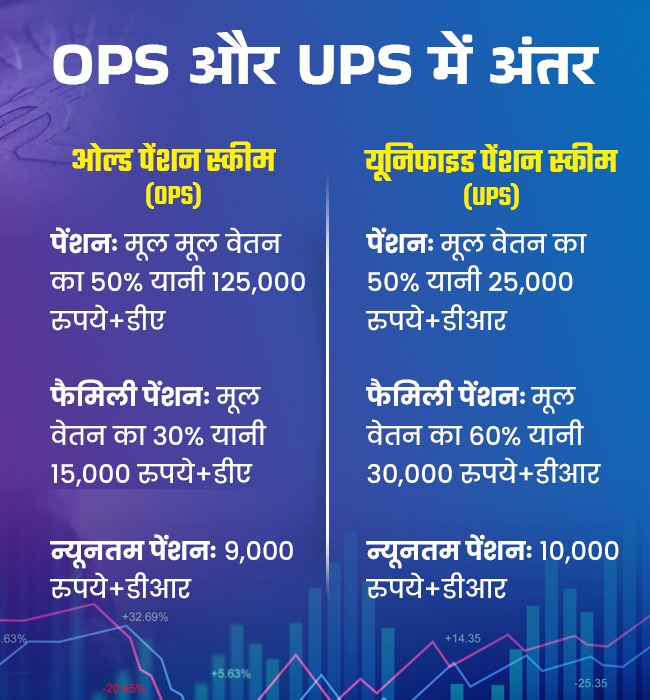
Business: The central government has given a big gift to the government employees who have been demanding the restoration of the Old Pension Scheme (OPS) for a long time. The cabinet led by Prime Minister Narendra Modi has approved the Unified Pension Scheme (UPS) for central government employees. It is very similar to the old pension scheme with some changes.
Unified Pension Scheme will benefit 23 lakh government employees. Its purpose is to guarantee assured pension, family pension and minimum pension to the employees. This reform will increase the sense of social and economic security of government employees to a great extent. This scheme will come into effect from April 1, 2025. State governments can also implement this scheme if they want.
Benefits of Unified Pension Scheme

This scheme will guarantee a guaranteed pension to the central government employees. If any retired employee has served for a minimum of 25 years, he will get 50 percent of his average basic salary of the 12 months before retirement as pension. This means that if the average basic salary is Rs 50,000, he will get Rs 25,000 every month as pension. If someone's service period is less, he will get less pension accordingly. It will be mandatory to serve for at least 10 years for pension.
Family pension and guaranteed minimum pension
In case of the death of the employee, the dependent will get 60 percent of the pension that the employee was getting before his death. This means that if an employee was getting a pension of Rs 25,000, then after his death the dependent will get Rs 15,000 per month. Its purpose is to provide financial security to the dependents of the employee. In the Unified Pension Scheme, there is a provision of pension of Rs 10,000 per month after a minimum service of 10 years. This will provide financial security to those employees whose salary is low.
Other Benefits of Unified Pension Scheme
The government will adjust all the three pensions given under the Unified Pension Scheme according to inflation. This means that the assured pension, family pension and minimum pension will be increased according to inflation.
- The pension of government employees will be based on the All India Consumer Price Index for Industrial Workers (AICPI-IW), similar to the provisions for serving employees.
- Government employees will get a lump sum payment equal to 1/10th of the monthly emoluments (pay + DA) as on the date of retirement for every completed six months of service in addition to gratuity. This will be completely separate from the assured pension.
Who can connect to UPS?
The central government has given its employees the option to remain in the National Pension System (NPS) or shift to the Unified Pension Scheme (UPS). After retirement, the option to choose between NPS or UPS will be available only once, which cannot be changed later. According to the government, UPS will be applicable to all those who have already retired under NPS since 2004.
UPS will be more beneficial than NPS
The government estimates that UPS will be more financially beneficial than NPS for more than 99 percent of the current central government employees. NPS has been in force since 2004. Employees retiring under NPS will also get the option to avail the new pension facility. If employees choose this option, the additional amount and its interest will be paid by the central government.
Talking about the Old Pension Scheme (OPS), the employee used to get 50 percent of his last salary as pension. The employee did not have to make any separate contribution. Only government employees were included in this. There was also a provision for Dearness Relief (DR). This means that the pension used to increase every six months according to inflation. Employees had to complete 20 years of service to get 50 percent pension.
In National Pension System (NPS), pension is given on the basis of investment. It is for all government and private employees. In this, government employees contribute 10 percent and the government contributes 14 percent. If the money of NPS is invested, then market benefits are also included in it. At the time of retirement, 60 percent of the total deposit can be withdrawn in lump sum. At the same time, 40 percent of the amount is received in the form of pension.
In Unified Pension Scheme (UPS), 50% of the average basic salary of the last 12 months will be given as pension. In case of serving for more than 10 years and less than 25 years, the benefit will be given proportionately. In this, the employee's contribution will be 10% and the government's contribution will be 18.5%. This contribution will not be invested in the market like NPS. There will also be a provision of DR of OPS in this. Employees with NPS will also be able to become a part of it.
Read More: Indo Count Industries shares surge 17%, boosted by Avendus' 'BUY' rating
--Advertisement--

 Priya
Priya Share
Share



